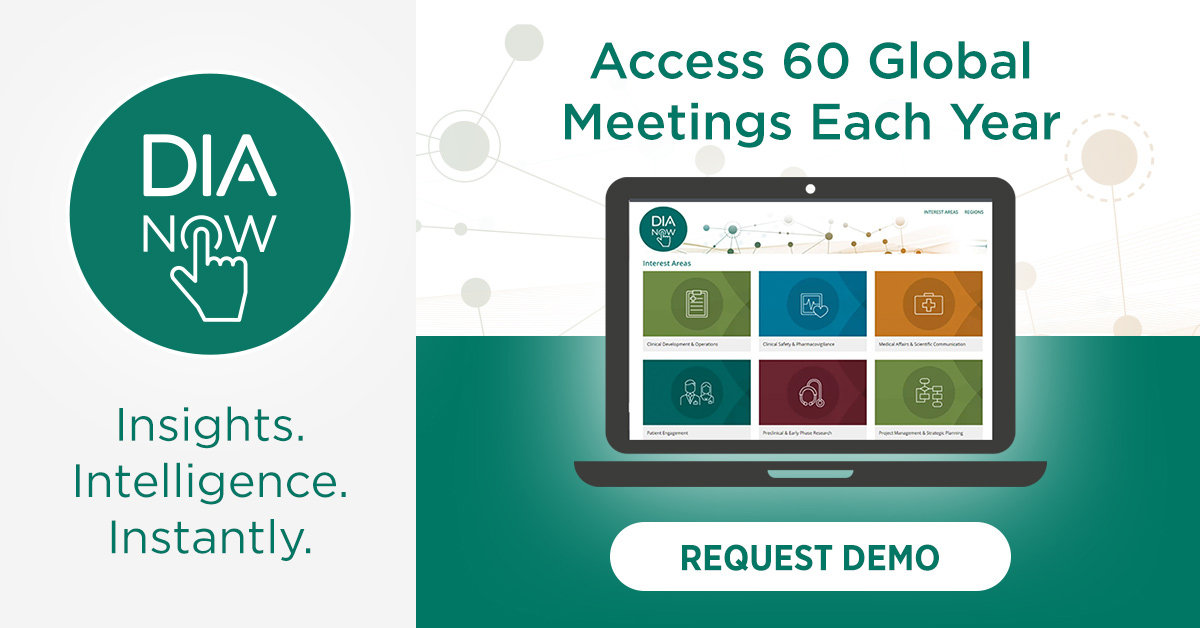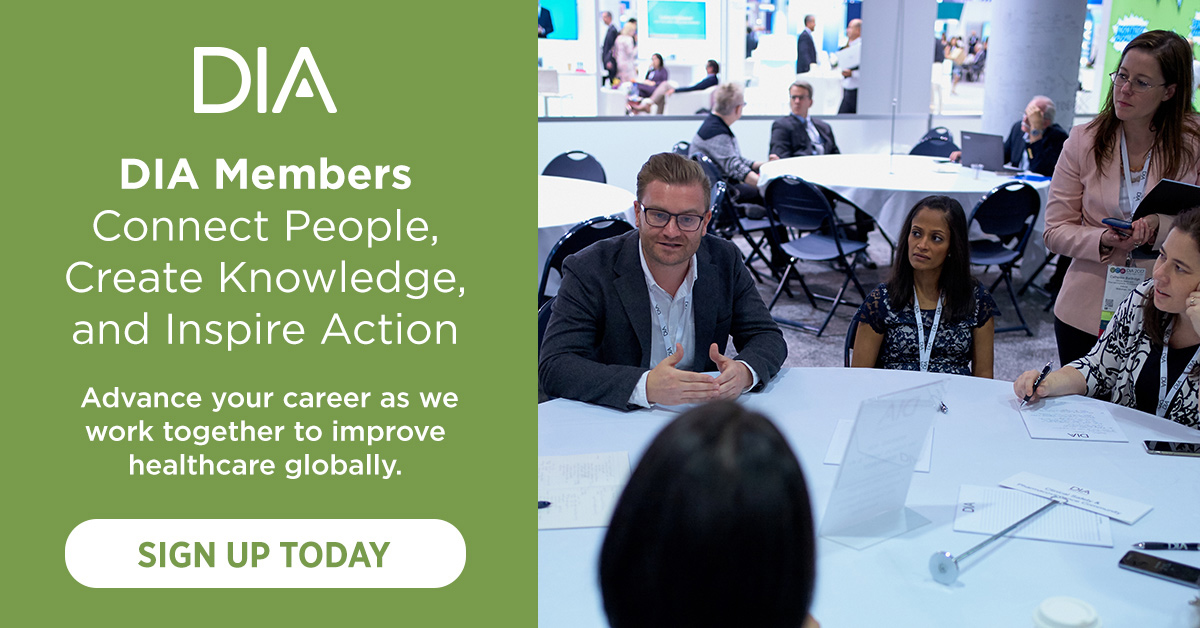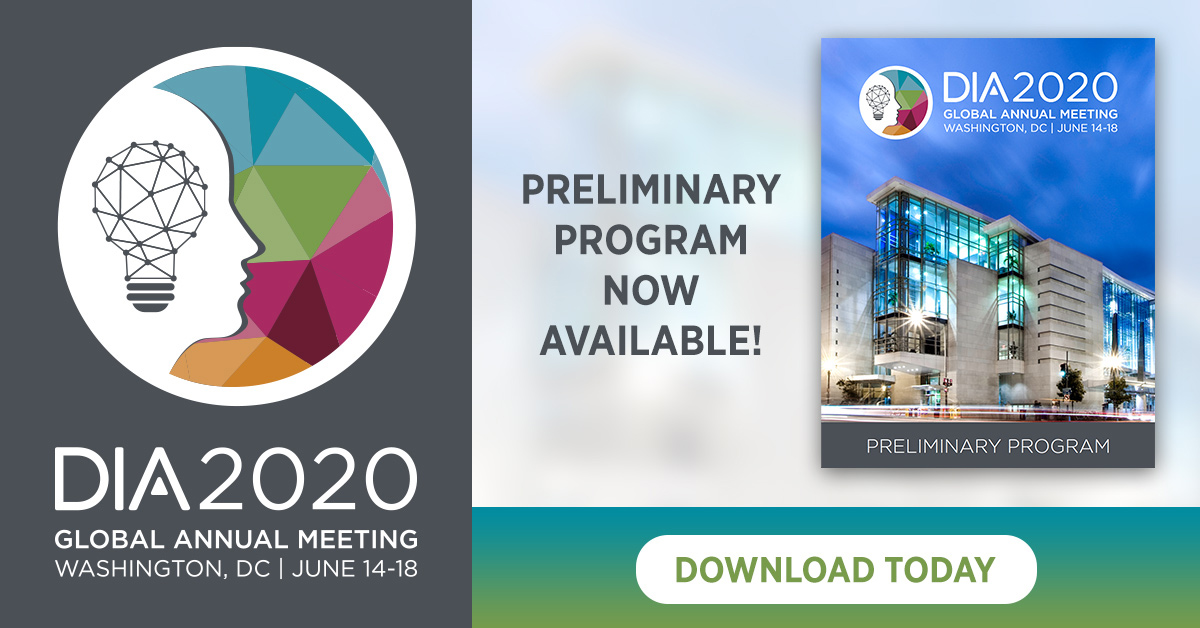April 2020 Global Forum
Table of Contents
EXECUTIVE LEADERSHIP
Subscribe
Love Global Forum‘s new online format? Subscribe today and never miss an issue.
Editorial Board
Content stream editors
Gary Kelloff US National Institutes of Health
David Parkinson ESSA Pharma, Inc.
regulatory science
Yoshiaki Uyama Pharmaceuticals and Medical Devices Agency (PMDA)
Adora Ndu BioMarin Pharmaceutical, Inc.
Patient engagement
Deborah Collyar Patient Advocates In Research (PAIR)
Lode Dewulf Servier
VALUE AND ACCESS
Monika Schneider Duke-Margolis Center for Health Policy
Editorial Staff
Alberto Grignolo, Editor-in-Chief Parexel International
Ranjini Prithviraj, Global Associate Director, Content Collaboration DIA Publications
Sandra Blumenrath, Science Writer DIA Publications
Chris M. Slawecki, Senior Digital Copyeditor DIA Publications
Regional Editors
David Mukanga Bill and Melinda Gates Foundation
ASEAN
Silke Vogel Duke-National University of Singapore Medical School
AUSTRALIA/NEW ZEALAND
Richard Day University of New South Wales, Medicine, St. Vincent’s Hospital
CANADA
Judith Glennie JL Glennie Consulting, Inc.
Megan Bettle Health Canada
CHINA
Ling Su Shenyang Pharmaceutical University, Lilly Asia Ventures
Europe
Thomas Kühler Sanofi R&D
INDIA
J. Vijay Venkatraman Oviya MedSafe
JAPAN
Akiko Ikeda Janssen Pharmaceutical K.K.
MIDDLE EAST
Inas Chehimi Novartis
USA
Ebony Dashiell-Aje BioMarin
Young Professionals Editor
DIA Membership
Bringing together stakeholders for the betterment of global health care.
Executive Leadership

Barbara Lopez Kunz
Global Chief Executive, DIA
his is an unusual time – for DIA, our families, our communities, and our world. We are seeing our lives transformed in unprecedented ways, requiring us to rapidly adjust and build the future as we go.
Change can be unsettling, but it can also create opportunities for doing things in new ways. How are we thinking about DIA’s role during the COVID-19 pandemic and the challenges and opportunities that lie ahead? We are maintaining an unrelenting focus on our mission! Those who know me understand my commitment to DIA’s role in the global healthcare ecosystem. We were founded 56 years ago by visionary leaders during another health crisis – Thalidomide – and for fifty-six years we have ensured that healthcare professionals around the globe share their knowledge to advance the science and policies to help patients access the safe and effective therapies they need.
New Normal? Takeaways from A Virtual Regulatory Inspection During COVID-19
Novartis Pharma GmbH, Germany
University of Hertfordshire, UK
magine the challenge: ahead of you is a Supervisory Authority inspection focusing on Good Pharmacovigilance Practices, with three inspectorates involved. You are the Qualified Person for Pharmacovigilance (QPPV) with oversight of the pharmacovigilance (PV) system of a multinational pharmaceutical company with a broad product portfolio comprising pharmaceutical medicines, biologicals, advanced therapy medicinal products (ATMPs), and gene therapy products. Fifty subject matter experts are planning to travel to mainland Europe in support of the inspection. The day before the inspection, a call is received requesting a remote inspection — to be conducted via video and telephone calls. The cause is the COVID-19 global pandemic. Outbreaks of COVID-19 affecting France, Switzerland, and Germany enforce a new approach as the WHO has released recommendations limiting travel.
Digital Twins: A Way Forward To Unlock the Pivotal Hidden Signals To Increase ROI in Drug Discovery?
Parexel International
Singapore
“Digital Twin” is a virtual or digital copy of a real-world product or living entity (at the atomic or macro geometric level), developed by integrating virtual blueprints with real world data, and optimized through Artificial Intelligence and Advanced Analytics software. The “Digital Twin” concept was introduced by Michael Grieves in 2003. Currently, Digital Twins are implemented in various manufacturing industries, predominantly in aerospace, automobiles, and space technology.
This article evaluates the lack of robustness in current drug development processes, from pre-clinical to late phase, and how Digital Twin models can bring sophistication to unlocking the hidden signals and to increase Return on Investment (ROI) in pharmaceutical R&D.
Investigator-Initiated Registry Trials in Japan and the REACTA Network in Asia
Chiba University Hospital
cademic research organizations (AROs) are ideally positioned to conduct collaborative clinical trials worldwide. Particularly regarding orphan diseases, rare cancer, and pediatric diseases that are difficult for pharmaceutical companies to address, it may be possible for academia to take the initiative in conducting clinical trials and solving various issues.
![]() Podcasts
Podcasts
Improving Site Compliance and Efficiency with eISF Harmonization
Veeva
Veeva
linical research sites face a growing number of regulatory, technical, and administrative hurdles associated with maintaining compliance. From this growth in complexity, the ability to produce documentation detailed enough to support compliance and quality data has overwhelmed regulators, sponsors, and, most of all, research sites. Standardization represents a significant opportunity to improve record keeping and simplify compliance at sites.
Sponsors Standardize on the TMF Reference Model
In 2009, sponsors and industry professionals from the DIA Documents and Records Management Community discovered that the list of essential documents listed in International Council for Harmonisation-Good Clinical Practice (ICH GCP) guidelines did not provide a complete scope of the actual records managed in their trial master file (TMF), the sponsor’s official record of the clinical trial. Document nomenclature and filing conventions varied wildly across teams and organizations, and inconsistencies in structure from one TMF to another made it difficult to speak the same language, review quality and completeness, and evaluate potential mergers and acquisitions.
The Promise and Problems of Real World Data and Evidence (RWD/RWE) for Patients and Companies
Patient Advocates In Research (PAIR)
Parexel Access
eal World Data (RWD) and Real World Evidence (RWE) are increasingly important to support product approvals and reimbursement for companies. They also have potential to help accelerate patient access to important new therapies. Patients, however, are more interested in Real World Answers (RWA) that must be rigorously and carefully studied in order to offer realistic value that translates into real improvements for patients, families, and healthcare systems.
![]() Podcasts
Podcasts
Around the Globe
Canhui Guo
WuXi AppTec (Shanghai) Co., Ltd.
he version of China’s Drug Administration Law passed by the People’s Congress of China in August 2019 came into effect on December 1, 2019. In this major revision of the Law, the most comprehensive revision since 2001, the regulatory philosophy has shifted from enterprise-based supervision to product-based supervision.
Implementation of the Marketing Authorization Holder (MAH) system is one of the key changes in the law. The MAH system had been implemented on a trial basis in ten provinces in China from 2015 to July 2019; during this trial period, 3239 product licenses were issued to 156 holders. It is now applicable to all companies applying to register a drug in China.
Around the Globe
2020 Latin America Regulatory Conference
Tamei Elliott
DIA
IA’s 2020 Latin America Regulatory Conference included nine sessions that described and discussed multi-regional cooperation, global harmonization, and best practices related to the regulatory landscape in Latin America.
Key Takeaways
- National Regulatory Authorities (NRAs) in Latin America are continuously working to progress advancement in the regulatory arena in their respective regions. Updates on several local, regional, and global projects were discussed and included priorities that would affect regulators and manufacturers in Latin America.
- Real World Data (RWD) and Real World Evidence (RWE) are playing an increasing role in healthcare decisions. RWE regulatory programs were explored for their potential use in medicinal product decision-making.
- Participants examined Pan American Health Organization (PAHO) activities related to the Latin America region, and delved into guidance regarding the World Health Organization’s (WHO) guidelines on procedures and data requirements for changes to approved biotherapeutics.
- Important topics of discussion included current progress, challenges, requirements, and perspectives for the future in areas such as advanced therapies and gene editing.
- An introduction to Continuous Manufacturing (CM) showed the future of integrated processing with fewer steps, no manual handling, shorter processing times, and increased efficiency. A harmonized approach to CM under ICH (International Conference of Harmonisation of Technical Requirements for Pharmaceuticals for Human Use) Q13 also showed the benefits of how industry and regulators could work together.
![]() Podcasts
Podcasts








